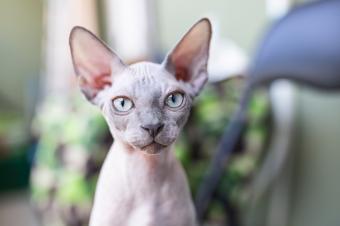
You're probably familiar with the Russian blue's distinctive and stunning appearance, but there's a lot more to the pretty blue cats than meets the eye. Did you know some of them are born with "ghost stripes?" Discover more about the Russian blue cat personality and fun facts you probably didn't know about the breed.
1. Russian Blues Might Not Be From Russia
The origins of the Russian blue are a little fuzzy. Some people believe these cats originated in Russia, as their name implies, while others say the breed is actually of Swedish descent. Not much else is known for sure prior to the breed being exported to England and the USA. But we do know that in 1949, the Russian blue was officially accepted by the Cat Fancier's Association (CFA) for registration.
2. They're Also Not Technically Blue
No cat is truly blue, although the Russian blue does come close. Their fur is a striking shade of bluish-gray with just enough silver tipping to give it a remarkable sheen. This color is what they're most well known for.
3. The Breed Has Captivating Eyes

The breed's other most distinctive characteristic is their eyes. They have rich, emerald-green eyes that make a stunning contrast against their blue fur.
4. And They Smile
Russian blues have a subtle little smile that some people compare to the Mona Lisa's smile. Are they holding onto a secret, or are they just super content with life? We'll never know.
5. Russian Blues Tend to Be One-Person Cats
Even though Russian blues will treat all members of the household with a certain amount of acceptance and affection, they usually single out one person to become their special friend and shower that lucky person with endless devotion.
Russian blues are cautious cats that like to take their time getting to know you and will usually do so from a distance before deciding whether to approach. If you're patient, you'll be rewarded with a calm and exceptionally loving companion.
6. The Breed Is Pretty Athletic
This isn't a frail or fragile breed. The Russian blue's body is muscular and toned, which makes them great athletes. Whether it's racing down the hallway or climbing a cat tree (or the curtains!), you can find Russian blues putting their endurance to the test.
Indoor house cats (yes, even Russian blues) can become overweight if they don't exercise enough. Make sure to keep your cat active with fun enrichment activities.
7. Russian Blues Are a Healthy Breed
Overall, these cats are pretty healthy, and there are no particular genetic diseases associated with the breed. Regular exercise and a healthy diet are generally all that is required to keep a Russian blue in good condition.
8. There's Controversy Around Crossbreeding

In recent years, there's been some outcrossing of Russian Blues to other breeds in an attempt to introduce color varieties within the breed. Some breeders feel strongly that this would take away from the breed's very unique look, and they are heartily against the move. In response to the controversy, the CFA Russian blue standard has been amended to specifically state that there are no outcrosses allowed and that long coats or any other colors are a disqualification.
9. Russian Blues Can Have "Ghost Stripes"
Some Russian blue kittens are born with "ghost stripes," which are barely visible tabby markings across their coat. Usually, these stripes will disappear as the kitten matures.
10. They're a Symbol of Good Luck
Cats, particularly black cats, are often associated with bad luck, but not the Russian blue. According to Russian folklore, these cats brought people good luck and were even brought inside the rooms of newborn babies to keep bad energy away.
Russian Blue Cat Personality & Traits
If you're looking for a beautiful and loyal companion, a Russian blue might just be the perfect fit. Not only are these cats lovely to look at, but if you are their special someone, they'll be loving and loyal.







